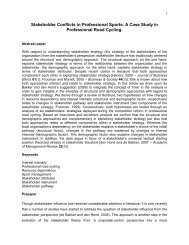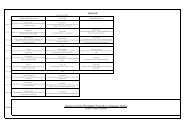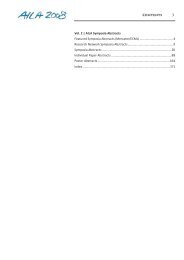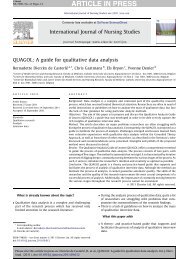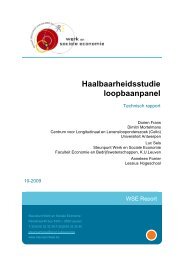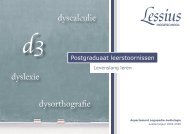The role of implicit attitudes towards food and ... - ResearchGate
The role of implicit attitudes towards food and ... - ResearchGate
The role of implicit attitudes towards food and ... - ResearchGate
Create successful ePaper yourself
Turn your PDF publications into a flip-book with our unique Google optimized e-Paper software.
Target stimuli physical activity:<br />
Sedentary behaviour words: reading, watching TV, resting<br />
Moderate intense physical activity words: walking, cycling, swimming<br />
High intense physical activity words: running, training, exercising<br />
References<br />
M. Craeynest et al. / Eating Behaviors 9 (2008) 41–51<br />
Barton, S. B., Walker, L. L. M., Lambert, G., Gately, P. J., & Hill, A. J. (2004). Cognitive change in obese adolescent losing weight. Obesity<br />
Research, 12, 313−319.<br />
Blair, I. (2002). <strong>The</strong> malleability <strong>of</strong> automatic stereotypes <strong>and</strong> prejudice. Personality <strong>and</strong> Social Psychology Review, 6, 242−261.<br />
Booth, S. L., Sallis, J. F., Ritenbaugh, C., Hill, J. O., Birch, L. L., Frank, L. D., et al. (2001). Environmental <strong>and</strong> societal factors affect <strong>food</strong> choice <strong>and</strong><br />
physical activity: Rationale, influences, <strong>and</strong> leverage points. Nutrition Reviews, 59, S21−S39.<br />
Braet, C. (2005). Psychological pr<strong>of</strong>ile to become <strong>and</strong> to stay obese. International Journal <strong>of</strong> Obesity, 29, S19−S23.<br />
Braet, C. (2006). Patient characteristics as predictors <strong>of</strong> weight loss after an obesity treatment for children. Obesity Research, 14, 148−155.<br />
Braet, C., Tanghe, A., De Bode, P., Franckx, H., & Van Winckel, M. (2003). Inpatient treatment <strong>of</strong> obese children: A multicomponent programme<br />
without stringent calorie restriction. European Journal <strong>of</strong> Pediatrics, 162, 391−396.<br />
Braet, C., Tanghe, A., Decaluwé, V., Moens, E., & Rosseel, Y. (2004). Inpatient treatment for children with obesity: Weight loss, psychological wellbeing,<br />
<strong>and</strong> eating behaviour. Journal <strong>of</strong> Pediatric Psychology, 29, 519−529.<br />
Cole, T. J., Bellizzi, M. C., Flegal, K. M., & Dietz, W. H. (2000). Establishing a st<strong>and</strong>ard definition for child overweight <strong>and</strong> obesity worldwide:<br />
International survey. British Medical Journal, 320, 1−6.<br />
Craeynest, M., Crombez, G., De Houwer, J., Deforche, B., Tanghe, A., & De Bourdeaudhuij, I. (2005). Explicit <strong>and</strong> <strong>implicit</strong> <strong>attitudes</strong> toward <strong>food</strong> <strong>and</strong><br />
physical activity in childhood obesity. Behaviour Research <strong>and</strong> <strong>The</strong>rapy, 43, 1111−1120.<br />
Cullen, K. W., Bartholomew, L. K., Parcel, G. S., & Koehly, L. (1998). Measuring stages <strong>of</strong> change for fruit <strong>and</strong> vegetable consumption in 9- to 12year-old<br />
girls. Journal <strong>of</strong> Behavioral Medicine, 21, 241−254.<br />
De Bourdeaudhuij, I., Lefevere, J., Deforche, B., Wijndaele, K., Matton, L., & Philippaerts, R. (2005). Physical activity <strong>and</strong> psychosocial correlates in<br />
normal weight <strong>and</strong> overweight 11 to 19 year olds. Obesity Research, 13, 1097−1105.<br />
De Houwer, J. (2003). <strong>The</strong> Extrinsic Affective Simon Task. Experimental Psychology, 50, 77−85.<br />
Dennison, C. M., & Shepherd, R. (1995). Adolescent <strong>food</strong> choice: An application <strong>of</strong> the <strong>The</strong>ory <strong>of</strong> Planned Behaviour. Journal <strong>of</strong> Human Nutrition<br />
<strong>and</strong> Dietetics, 8, 9−23.<br />
Fazio, R. H., & Olson, M. A. (2003). Implicit measures in social cognition research: <strong>The</strong>ir meaning <strong>and</strong> use. Annual Review <strong>of</strong> Psychology, 54,<br />
297−327.<br />
Fazio, R. H., Sanbonmatsu, D. M., Powell, M. C., & Kardes, F. R. (1986). On the automatic activation <strong>of</strong> <strong>attitudes</strong>. Journal <strong>of</strong> Personality <strong>and</strong> Social<br />
Psychology, 50, 229−238.<br />
Greene, G. W., Fey-Yensan, N., Padula, C., Rossi, S., Rossi, J. S., & Clark, P. G. (2004). Differences in psychosocial variables by stage <strong>of</strong> change for<br />
fruit <strong>and</strong> vegetables in older adults. Journal <strong>of</strong> the American Dietetic Association, 104, 1236−1243.<br />
Greenwald, A. G., Banaji, M. R., Rudman, L. A., Farnham, S. D., Nosek, B. A., & Mellot, D. S. (2002). A unified theory <strong>of</strong> <strong>implicit</strong> <strong>attitudes</strong>,<br />
stereotypes, self-esteem, <strong>and</strong> self-concept. Psychological Review, 109, 3−25.<br />
Greenwald, A. G., McGhee, D. E., & Schwartz, J. L. (1998). Measuring individual differences in <strong>implicit</strong> cognition: <strong>The</strong> Implicit Association Test.<br />
Journal <strong>of</strong> Personality <strong>and</strong> Social Psychology, 74, 1464−1480.<br />
Huijding, J., & de Jong, P. (2005). A pictorial version <strong>of</strong> the Extrinsic Affective Simon Task — Sensitivity to generally affective <strong>and</strong> phobia-relevant<br />
stimuli in high <strong>and</strong> low spider fearful individuals. Experimental Psychology, 52, 289−295.<br />
Lissau, I., Overpeck, M. D., Ruan, W. J., Due, P., Holstein, B. E., & Hediger, M. L. (2004). Body mass index <strong>and</strong> overweight in adolescents in 13<br />
European countries, Israel, <strong>and</strong> the United States. Archives <strong>of</strong> Pediatrics <strong>and</strong> Adolescent Medicine, 158, 27−33.<br />
Morgan, C. M., Tan<strong>of</strong>sky-Kraff, M., Wilfley, D. E., & Yanovski, J. A. (2002). Childhood obesity. Child <strong>and</strong> Adolescent Psychiatric Clinics <strong>of</strong> North<br />
America, 11, 257+.<br />
Prochaska, J. O., & DiClimente, C. C. (1983). Stages <strong>and</strong> processes <strong>of</strong> self-change <strong>of</strong> smoking: Toward an integrative model <strong>of</strong> change. Journal <strong>of</strong><br />
Consulting <strong>and</strong> Clinical Psychology, 51, 390−395.<br />
Schwarz, N. (1999). Self-reports. How the questions shape the answers. American Psychologist, 54, 93−105.<br />
Steffens, M. C. (2004). Is the Implicit Association Test immune for faking? Experimental Psychology, 51, 165−179.<br />
Teachman, B. A., & Woody, S. R. (2003). Automatic processing in spider phobia: Implicit fear associations over the course <strong>of</strong> treatment. Journal <strong>of</strong><br />
Abnormal Psychology, 112, 100−109.<br />
Teige, S., Schnabel, K., Banse, R., & Asendorpf, J. B. (2004). Assessment <strong>of</strong> multiple <strong>implicit</strong> self-concept dimensions using the Extrinsic Affective<br />
Simon Task (EAST). European Journal <strong>of</strong> Personality, 18, 495−520.<br />
Valverde, M. A., Patin, R. V., Oliveira, F. L. C., Lopez, F. A., & Vitolo, M. R. (1998). Outcomes <strong>of</strong> obese children <strong>and</strong> adolescents enrolled in a<br />
multidisciplinary health program. International Journal <strong>of</strong> Obesity, 22, 513−519.<br />
51




